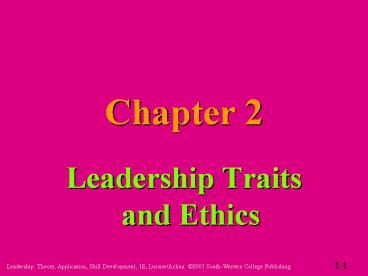Leadership Traits and Ethics - PowerPoint PPT Presentation
1 / 19
Title:
Leadership Traits and Ethics
Description:
Leadership: Theory, Application, Skill Development, 1E, Lussier/Achua 2001 ... Motivation Theory and Leader Profile. Theory X, Theory Y, Pygmalion ... Theory ... – PowerPoint PPT presentation
Number of Views:1541
Avg rating:3.0/5.0
Title: Leadership Traits and Ethics
1
Chapter 2
- Leadership Traits and Ethics
2-1
2
Chapter 2 Learning Objectives
- Benefits of classifying traits.
- Big Five personality dimensions.
- Universality of leaders traits.
- Trait of dominance.
- Achievement Motivation Theory and Leader Profile.
- Theory X, Theory Y, Pygmalion Effect.
- Four leadership styles and attitude.
- Stakeholder approach to ethics.
2-2
3
Two Meanings of Personality
- The impression a person makes on others
- The unseen structures and processes inside a
person that explain why we behave the way we do.
4
Traits
- Traits refer to regularities or trends in a
persons behavior. - The trait approach to personality maintains that
people behave the way they do because of the
strength of the traits they possess.
5
Great Man (Person) Approach
- Sought to identify
- the traits effective
- leaders possessed.
2-3
6
Big Five Model of Personality
Surgency
Adjustment
Agreeableness
Open to experience
Conscientiousness
2-4
7
Big Five Model of Personality
Surgency
Adjustment
Agreeableness
Open to experience
Conscientiousness
2-4
8
Advantages of Big 5 Model
- Advantages of the Big Five Model
- Provides explanation of leader and follower
tendencies. - Personality traits tend to be constant over time.
- Important for leader to know own traits to assess
likelihood of success in various environments - Successfully works in many environments.
9
Advantages of Big 5 Model
- Useful categorization scheme for discussions
- Good profiling for corporate and occupational
functions - Universally accepted across cultures
10
Disadvantages of Big 5 Model
- 5 factors are not enough to adequately encompass
all the different personality traits - Dimensions tend to be fairly heterogeneous
internally, which makes them poor predictors of
job performance
11
6 Major Reasons for Executive Derailment
2-5
12
Locus of Control
Integrity
High energy
Flexibility
9 Traits of Effective Leaders
Dominance
Sensitivity to others
Self-confident
Intelligence
Stability
2-6
13
Achievement MotivationTheory
- attempts to explain and predict behavior and
performance based on ones need for achievement,
power, and affiliation.
2-7
14
Need for Achievement
- Unconscious concern for excellence in
accomplishments through individual efforts - Goal oriented, set moderate, realistic,
attainable goals - Seek challenge, excellence, individuality
- Take calculated, moderate risk
- Desire feedback, work hard
15
Need for Power
- Unconscious concern for influencing others and
seeking positions of authority - Want to control situation, influence others
- Enjoy competition they can win
- Willing to confront others, seek positions of
authority status
16
Need for Affiliation
- Unconscious concern for developing, maintaining,
and restoring close personal relationships - Want to be liked by others, enjoy social
activities, seek to belong - Enjoy developing, helping, and teaching others
- More concerned about what others think of them
rather than getting their own way
17
Theory X.................Theory Y(Autocratic)
(Participative)
Control
Support
2-8
18
Pygmalion Effect
- Managers attitudes, expectations, and treatment
of employees explain and predict behavior and
performance..
2-9
19
If you think you canyou can,if you think you
cant,you cant.
2-10
20
Ways to Develop a Positive Self-Concept
- Maintain a positive. Optimistic attitude--few, if
any, benefits to negative pessimistic attitudes
about others - Cultivate optimistic thoughts
- If you catch yourself complaining, stop and
change to positive statements - Avoid negative people!!
21
Ways to Develop a Positive Self-Concept
- Set and achieve goals
- Focus on successes--do not dwell on failures
- Accept compliments
- Think for yourself
- Do things to help others less fortunate--youre
never as bad off as you think
22
Leadership Styles Based on Attitudes
Theory Y Attitudes
Theory X Attitudes
Positive Self-Concept
Gives and accepts positive feedback Expects
others to succeed Lets others do the job their
way
Bossy Pushy Impatient Critical Autocratic
Negative Self-Concept
Pessimistic Promotes hopelessness
Afraid to make decisions Unassertive Self-bla
ming
2-11
23
Golden Rule
- Do unto others as you want them to do unto you.
- or
- Dont do anything to anyone that you would not
want them to do to you.
2-12
24
Stakeholders Approach to Ethics
- creates a win-win situation for relevant parties
affected by the decision.
Win-Win
2-13































